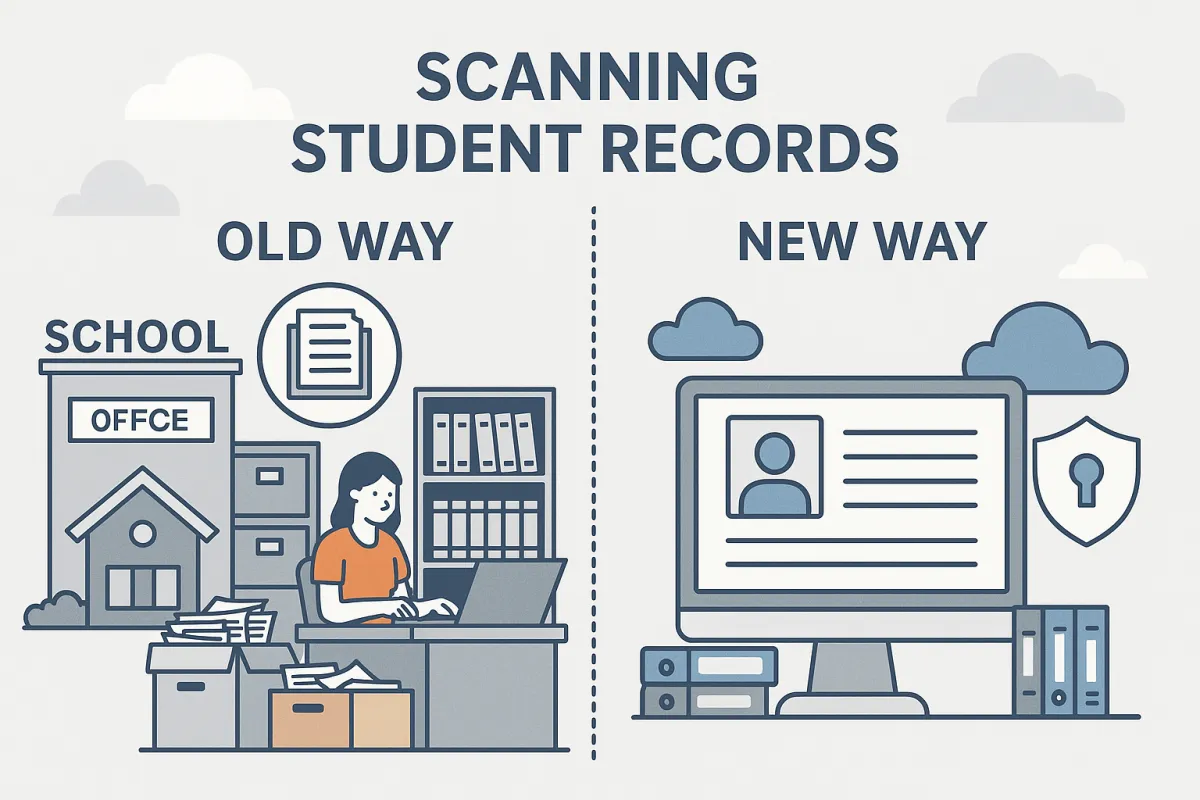
Smarter Records Management for Schools: Why Digital Scanning Matters
By: USA IMAGING, Inc.
If you’ve ever stepped into a registrar’s office, you know the sight: long rows of filing cabinets, banker’s boxes stacked high, and rows of shelves holding decades’ worth of student records. These papers represent the lifeblood of an institution—every transcript, enrollment form, health waiver, and financial aid application a student has ever submitted.
But while these files are important, managing them on paper comes with challenges. Records get misplaced. Storage rooms fill up. Staff waste valuable time digging for documents. And let’s face it—paper is fragile. Water, fire, or even just years of handling can permanently destroy information.
That’s where digital scanning comes in. For schools and universities, scanning student records isn’t just about going paperless—it’s about creating a smarter, safer, and more efficient way to serve students and administrators alike.
The Complexity of Student Records
Unlike simple office files, student records are multifaceted and legally sensitive. A single student can accumulate dozens of different file types, including:
Admissions and enrollment forms
Transcripts and grade reports
Attendance and disciplinary records
Immunization and health documents
Financial aid applications and supporting paperwork
Test scores and placement exams
Graduation or transfer certifications
Multiply this by hundreds—or thousands—of students in a district or university, and you can quickly see why many institutions are drowning in paper. Each document must be maintained, retrievable, and protected according to compliance rules like FERPA (Family Educational Rights and Privacy Act).
Why Digital Scanning Is the Solution
1. Quick Access for Administrators and Students
When a graduate calls ten years later needing a transcript, staff shouldn’t have to sift through dusty cabinets to find it. With scanned files, staff can search by name, student ID, or graduation year and retrieve the record instantly. What once took hours now takes seconds.
2. FERPA Compliance and Data Security
FERPA requires strict protection of student records. Paper files sitting in unlocked cabinets can be a liability. Digitized records can be stored in secure repositories, protected with encryption, access controls, and audit trails showing who viewed or modified the data. This means better compliance—and peace of mind.
3. Space Savings That Pay Off
Schools often dedicate entire rooms—or even buildings—to file storage. By scanning, those cabinets and boxes can be eliminated, freeing up space for classrooms, labs, or student services. For universities where square footage is at a premium, this space savings translates into real dollars.
4. Disaster Preparedness
What happens if there’s a flood in the basement where records are kept? Or a fire? Or simply mold and deterioration over time? Paper doesn’t last forever. Digitized files can be backed up across multiple secure locations, both on-premise and in the cloud. That means even in a worst-case scenario, critical student records are preserved.
5. Long-Term Preservation
Student records are often required to be kept indefinitely. But paper naturally degrades—ink fades, paper yellows, edges tear. Scanning preserves these documents in crisp digital formats that will remain legible and usable decades from now.
6. Workflow Integration
Once digital, records can be integrated into systems schools already use—like Student Information Systems (SIS) or Learning Management Systems (LMS). This makes them far more than static archives; they become part of the school’s daily operations.
The Process: How USA IMAGING, Inc. Handles School Records
We know that educational records aren’t just “any documents.” They’re sensitive, personal, and vital to both compliance and the student experience. That’s why our process is carefully designed:
Pickup or On-Site Scanning – We securely transport files to our facility or bring scanning equipment to your school.
Document Prep – Staples, clips, and fasteners are removed. Torn pages are repaired. Sticky notes are relocated so no information is lost.
Scanning – High-speed, high-quality scanners digitize everything from standard pages to oversized documents like report ledgers.
OCR (Optical Character Recognition) – This step makes every document searchable by keyword. A quick search for “Anderson, 2008” will pull up exactly what you need.
Indexing – Records are organized by metadata such as student name, ID number, birthdate, or year of graduation. Digital bookmarks can mimic binder tabs for easy navigation.
Quality Control – Every image is reviewed for clarity and completeness. We perform 100% QC so nothing is missed.
Secure Storage Delivery – Files can be returned on encrypted drives, loaded into a secure cloud, or delivered via custom portals.
Optional Shredding – Once digitized, paper records can be securely shredded, freeing schools from decades of bulky storage.
Real-World Example: A School District Success Story
One local district had decades of student records stored in multiple off-site warehouses. Staff had to submit a request and wait days—sometimes weeks—for a box to be delivered, only to find the file they needed was missing.
After digitizing with USA IMAGING, Inc., the district moved everything into a searchable digital repository. Now, when a former student requests a transcript, staff can pull it up instantly. The district also closed down three rented storage facilities, saving thousands of dollars annually in storage costs alone.
The Future of Education Is Digital
Education is evolving. Online learning, hybrid classrooms, and student portals are becoming the norm. But student record-keeping is often still stuck in the past. Digital scanning bridges that gap, bringing record management up to speed with the rest of modern education.
With secure, searchable, and easily accessible digital records, schools and universities can focus less on paperwork and more on what matters most: serving their students.
📞 Contact Us: 858-513-6565
📩 Request a Quote: Click Here
